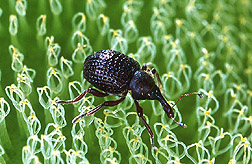This page has been archived and is being provided for reference purposes only. The page is no longer being updated, and therefore, links on the page may be invalid.
Giant Salvinia Attacked by Tiny WeevilBy Marcia WoodDecember 18, 2001 A fern with a reputation as one of the world’s worst aquatic weeds is showing up in ponds, lakes and reservoirs from North Carolina to Hawaii. When conditions are right, giant salvinia--Salvinia molesta--forms dense mats that can double in a few days. Sometimes more than 2 feet thick, the mats block out sunlight that other plants need and use up oxygen that fish, insects and other aquatic dwellers require. The weed also ruins conditions for fishing, boating and waterskiing and clogs irrigation and electrical generating systems. Agricultural Research Service scientists in the United States and Australia are working to stop this pest. Researchers based at ARS laboratories in Fort Lauderdale, Fla., and in the Brisbane suburb of Indooroopilly, Australia, are leading new studies of the genetic makeup and appetite of a tiny, salvinia-eating weevil. The object of their attention is a dark-colored, one-tenth-inch-long weevil known as Cyrtobagous salviniae, obtained from another salvinia species, Salvinia minima, or common salvinia, that grows in Florida. The C. salviniae weevil has earned kudos internationally for holding salvinia in check, according to Ted D. Center, director of the ARS Invasive Plant Research Laboratory in Fort Lauderdale and Gainesville. The helpful insect has already been used--with great success--in more than 13 countries. Philip W. Tipping and other researchers at the Fort Lauderdale lab have collected more than 800 salvinia weevils from common salvinia in Florida. They turned the weevils loose in an east Texas pond and lake and in a reservoir on the Texas-Louisiana border. The scientists have begun to make additional releases. For this work, however, they are using weevils collected from Australia rather than from Florida. In Australia, the weevils provided dramatic and rapid results in battling salvinia. The weevils that the researchers have set free at salvinia-infested sites are descendants of weevils collected by the team that ARS colleague John A. Goolsby leads in Indooroopilly. ARS researchers are the first in the United States to use an insect to attack salvinia. ARS is the U.S. Department of Agriculture’s chief scientific research agency. |

